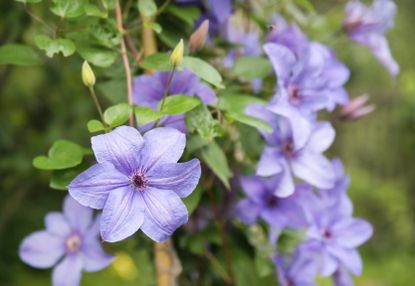Clematis Bloom Times: How Long Do Clematis Bloom


Clematis is a popular addition to flower gardens, and for good reason. It’s a perennial that climbs effortlessly and should reliably produce cascades of bright blooms for years. When exactly can you expect these blooms? There’s no easy answer to this question, as the wide range of varieties bloom at such different times and for such different durations. Keep reading for a basic rundown of clematis vine flowering times.
When Do Clematis Bloom?
There are a huge number of clematis species, all with slightly different blooming idiosyncrasies. Some clematis bloom times are in the spring, some in summer, some in autumn, and some are continuous through multiple seasons. Some clematis also have two distinct blooming periods. Even if you do plant a specific variety for its bloom time, sunlight, USDA zone, and soil quality can cause it to deviate from your expectations. There are some basic guidelines, however. Spring-blooming clematis species include:
- alpina
- armandii
- cirrhosa
- macropetala
- montana
Summer-blooming and fall-flowering clematis include the following species:
- crispa
- x durandii
- heracleifolia
- integrifolia
- orientalis
- recta
- tangutica
- terniflora
- texensis
- viticella
The florida species blooms once in the spring, stops producing, then blooms again in the autumn.
Blooming Season for Clematis
Blooming season for clematis can be extended if you plant the right variety. Some specific cultivars have been bred to bloom continuously through the summer and fall. These hybrid clematis include:
- Allanah
- Gypsy Queen
- Jackmanii
- Star of India
- Ville de Lyon
- Polish Spirit
- Red Cardinal
- Comtesse de Bouchard
Planting one of these is a good way to ensure clematis vine flowering for an extended period of time. Another good strategy is to overlap multiple varieties. Even if you can’t exactly pinpoint your clematis bloom times, planting a spring variety near summer and fall varieties should make for continuous flowering throughout the growing season.
Gardening tips, videos, info and more delivered right to your inbox!
Sign up for the Gardening Know How newsletter today and receive a free download of our most popular eBook "How to Grow Delicious Tomatoes."

The only child of a horticulturist and an English teacher, Liz Baessler was destined to become a gardening editor. She has been with Gardening Know how since 2015, and a Senior Editor since 2020. She holds a BA in English from Brandeis University and an MA in English from the University of Geneva, Switzerland. After years of gardening in containers and community garden plots, she finally has a backyard of her own, which she is systematically filling with vegetables and flowers.
-
 How To Get Rid Of Mosquitoes In The Garden: 9 Natural Ways To Make Them Buzz Off!
How To Get Rid Of Mosquitoes In The Garden: 9 Natural Ways To Make Them Buzz Off!How to get rid of mosquitoes is on the minds of people in the summer in almost every region of the world. Learn how to repel the pests without toxic chemicals.
By Mary Ellen Ellis
-
 Monkey Orchid Care: How To Grow This Fascinating Species
Monkey Orchid Care: How To Grow This Fascinating SpeciesThe monkey orchid bears a remarkable resemblance to its namesake and, with a little know-how, can be successfully grown as a houseplant.
By Bonnie L. Grant